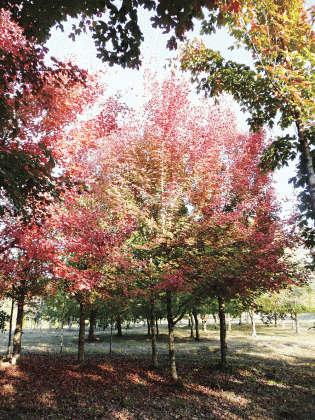
Dan Gill / LSU AgCenter Horticulturist
February is an excellent time to fertilize trees. Most trees are just beginning to enter a growth phase or will within a few weeks. Fertilizing this month provides them with nutrients just when they can use them most effectively.
Most of us tend to take our landscape trees for granted. Lavishing attention on our lawns, shrubs and flower beds, we forget that trees are growing, living plants, too. And they require some of the same care. In particular, the benefits of fertilizing trees are often overlooked.
Trees growing in an urban landscape are more likely to need fertilization than those growing in a more natural habitat. In the wild, leaves decay in place under the trees that dropped them, recycling the nutrients contained in fallen leaves back to the tree. When we rake up and dispose of fallen leaves to keep our yards neat and lawns healthy, we deprive trees of the nutrients the leaves contain. In addition, urban trees can face lower fertility levels due to topsoil removal during initial construction, soil compaction, paved areas and competition from other landscape plants.
Fertilization can be effective in helping trees in a number of ways.
In the first five to 10 years after planting, young shade trees can be encouraged to grow more rapidly with annual, moderate fertilization. Keep in mind that naturally fast-growing trees such as lacebark elm, swamp red maple, tulip poplar, sycamore and green ash need less fertilizer to achieve the desired fast growth rate. Indeed, excessive fertilization may result in an undesirable weaker branch structure.
Newly planted trees should be fertilized lightly or not at all in the first year after planting to avoid stimulating excessive vegetative growth before the tree has a chance to establish a strong root system.
Proper fertilization also helps maintain the existing growth, health and vigor of more mature trees. Trees provided with proper nutrient levels are better able to deal with adversities such as insect and disease problems or urban stress.
Mature shade trees generally do not need to be fertilized annually. Applications every three years are generally adequate.
When trees are damaged or in decline, fertilization, along with cultural practices, can be an important part of a recovery program. Trees are often injured by construction or filling, which damages their root system. Physical injury to the upper part of the tree can occur from pruning, lightening, squirrels and lawn maintenance equipment. By increasing a tree’s vigor, fertilization can speed healing and help them recover.
If you’re not sure if you should fertilize, you can determine the need for fertilization of healthy, mature trees by observing the amount of growth they make in spring. If more than 6 inches of new growth is apparent, fertilization is not needed. If growth is between 2 inches and 6 inches, you may consider fertilizing. Fertilization is recommended if a mature tree has less than 2 inches of new twig growth.
Also, look at the foliage of a tree. If leaves are abnormally small, pale or yellowish, a lack of nutrients could be to blame. Premature fall color and leaf drop in deciduous trees can also indicate a need for fertilization.
Check the pH — soil acidity — and nutrient levels of the soil by having it tested. You can have this done through your local parish LSU AgCenter office. The test can determine if you have a problem with pH or a lack of important nutrients.
Poor color and growth can also occur due to recent transplanting, application of excessive fill, construction, poor drainage, root diseases, insect or disease damage to the foliage, herbicide injury or mechanical damage — particularly to the base of young trees from lawn mowers and string trimmers. Proper fertilization can help trees recover from some of these problems if the cause is also corrected.
Trees can be fertilized in many different ways, and you can use a variety of products. Read the label directions carefully and follow them precisely.
Young trees can be fertilized by simply scattering fertilizer around them. Even larger trees can be fertilized effectively by scattering fertilizer on the soil surface in the root zone. Focus fertilizer applications in a donut-shaped area that centers on the farthest reach of the branches.
Where lawns may be affected by the fertilizer — by the way, trees do get their share of fertilizer you put down for your lawn — it can be placed in holes 1 inch across and 8 inches deep evenly scattered in the root zone of the tree. Tree fertilizer spikes can also be used to accomplish about the same thing.
If you prefer, you can contact a local tree service to come out and fertilize your tree for you. This might be better for larger, older trees with extensive root systems.
For more information on fertilizing trees, contact your local LSU AgCenter office.
